Sales tracking is more than numbers and graphs.
To get an accurate idea of what tactics are working and where your sales team should be focusing their efforts, you need a complete picture of the entire sales process. And that’s where sales tracking comes into play.
Sales tracking analyzes every part of the sales process, from activity and pipeline metrics to win rates and everything else that goes into closing a deal.
Tracking the sales process from start to finish helps you understand how every sales-based activity impacts the way deals move through the pipeline. In return, you can uncover bottlenecks in the pipeline and pinpoint which strategies are driving the most sales.
This guide is going to break down why sales tracking is the key to improved process and performance, outline which metrics your sales team should be tracking, and detail how to set up an efficient sales tracking framework.
Let’s get tracking!
How Sales Tracking Can Dial In Your Sales Process
Sales tracking does just that—tracks your sales, down to every detail.
Having a birds-eye view of your sales process means not only can sales managers make smarter decisions, but they can also better determine which sales strategies are sustainable.
Here are some of the top reasons you should consider investing in sales tracking.
Sales Tracking Helps Managers Quickly Spot Pipeline Bottlenecks
Are you getting plenty of leads, but failing to convert them into customers?
The problem could be a bottleneck in your pipeline; leads are entering your sales funnel, but at some stage of the selling process, they’re dropping away. With sales tracking, it’s easier to see exactly where your leads are leaking out of your sales funnel, which makes it easier to fix the problem.
For example, your reps might be booking a ton of meetings, but with sales tracking, you may find out that a lot of those meetings are getting cancelled. Or, if your sales reps are giving a lot of demos to prospects with a low opportunity-close rate, there could be a problem with the way they’re pitching or presenting.
With the right sales tracking software, these issues can be tracked automatically. For example, in SPOTIO’s conversion dashboard, you can track where all of your leads are at in your sales pipeline:

Image: SPOTO conversion metrics report.
And if you’ve lost leads—it can tell you why:
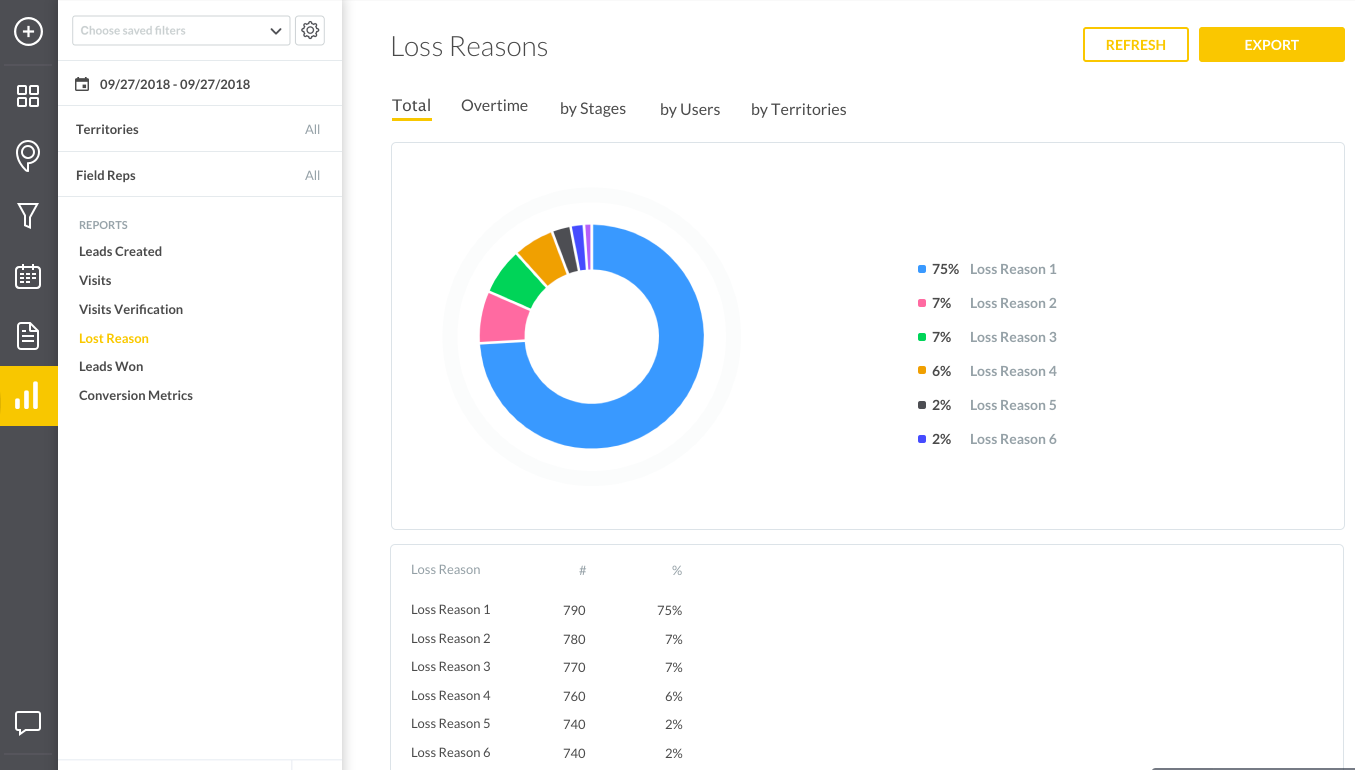
This level of real-time insight can be critical in fixing a leaking pipeline before it eats away at your bottom line.
Sales Tracking Helps Managers See Which Territories, Teams and Reps Are Driving the Most Leads, Opportunities and Revenue
Managers can’t be everywhere at once.
Sales tracking enables managers to get real-time updates on how every rep is performing. This is not only helpful for identifying who is doing well, but also who might need some additional assistance, whether that be training, technology or better territory assignments.
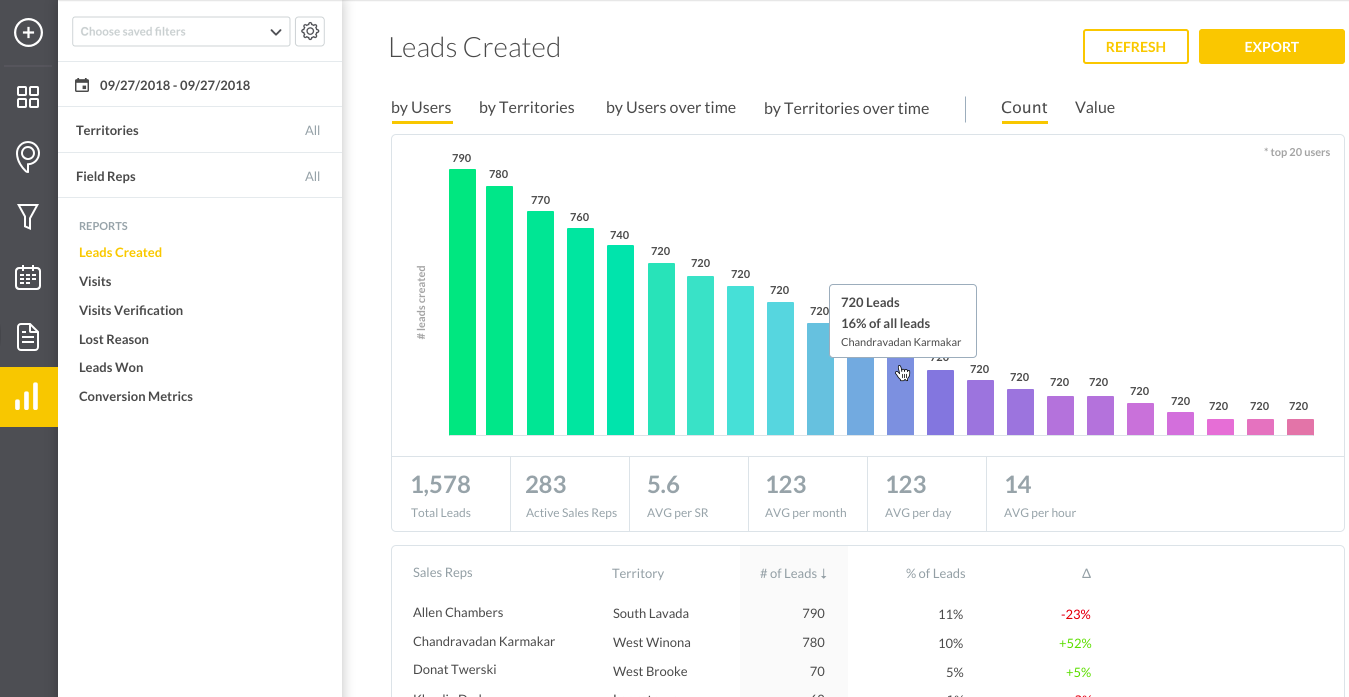
Image: SPOTIO executive insights report showing leads volume and value by rep and territories.
Picture this: you have ten sales reps out in the field. Eight of them are consistently reaching (or beating) their quotas. The other two? Well, they’re having trouble closing enough deals to meet their monthly targets.
With sales tracking, you can take a look at the data for the two reps that are falling behind and see what parts of the sales process they’re struggling with. Instead of looking at them as underperforming sales reps, you can fix individual issues in their selling processes and get them back on track to hitting quota.
Sales Tracking Helps Prioritize How Reps Spend Their Time
If your reps are out in the field, you expect them to be selling, right?
Well, it might surprise you that their time is constantly being filled with non-sales activities. In fact, a Salesforce study found sales reps are spending an eye-watering 64% of their time on non-selling activities.
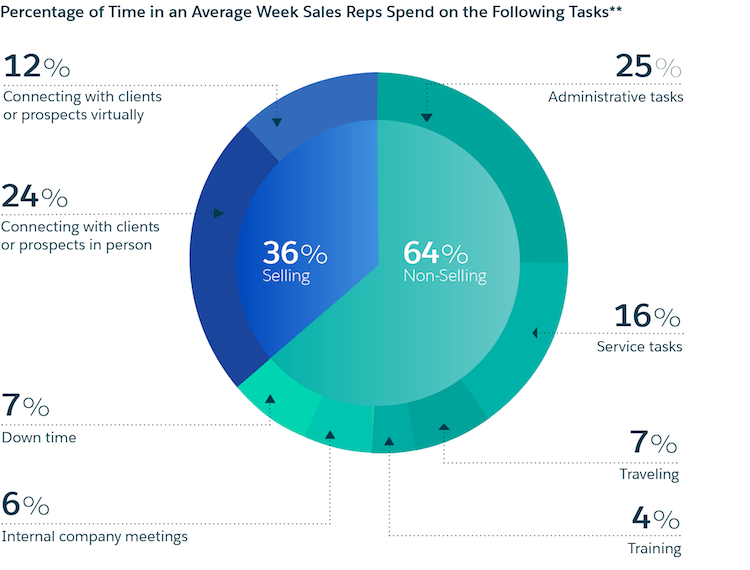
With statistics like this, it’s more important than ever for sales managers to find ways to prioritize their rep’s time. Sales tracking makes this possible.
For example, reps can use SPOTIO to spot sales opportunities near them when they’re out on the field:

Instead of spending time with their heads in their laptops searching for addresses, sales reps can easily prioritize touchpoints close to them. Even better, sales tracking technology segments leads by sales stage, so reps can prioritize leads that are further down the funnel and close more deals, faster.
Sales Tracking Help Identify Which Sales Activities Are Best At Moving Deals Through the Pipeline
According to RAIN Group, it takes an average of 8 touches to get an initial meeting with a new prospect.
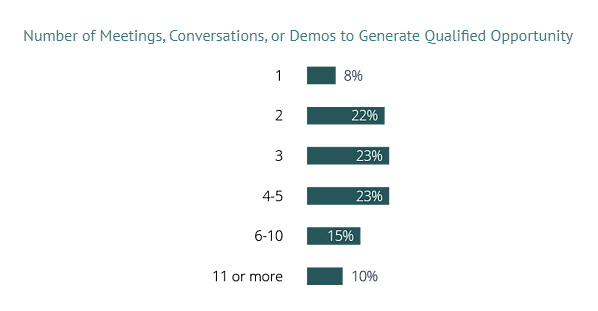
For most organizations, inside or in the field, the sales process hinges on more than follow up phone calls. It now demands a truly multi-channel strategy – phone calls, emails, text messages, social media interactions and in-person visits.
But, with so many touch points across different channels, it’s critical for organizations to be able to understand which communications are moving the needle.
Sales tracking provides an accurate view into which channels are being used the most, and which ones are impacting the bottom line. Managers can even drill into the messages and create templates that can be used by other reps to improve close rates and shorten the sales cycle.
For example:
If sales reps are having more luck booking demos while they’re out in the field then over email, then you can prioritize their time to ensure more office visits are being made.
Sales tracking will also keep a real-time activity log of every interaction so if your prospects change their preferences in how they like to be contacted—you can act on it quickly.
Sales Tracking Can Provide Team Accountability
No one likes a big brother complex.
But, one of the biggest concerns for outside sales managers is whether or not reps are working accounts as they should be.
If your reps are out in the field all day, you want to make sure they’re following schedules and visiting enough accounts. Sales tracking software is equipped with GPS location tracking, so even if you are in the office, you can check to see where reps are, and which accounts they are actively working.
![]()
Image: Dropping pins inside SPOTIO’s sales rep tracking app.
For example, SPOTIO’s rep tracking feature can pinpoint where every rep is at any point in the day. Managers can keep track of their:
Location: So you know they are where they say they are.
Status: Are they doing a demo or at lunch?
Date and time-stamped data: Exact day and time each activity is logged.
Maps: see where a pin was dropped and compare it to where their device was pinged.
Not only does this make it easier to track your reps, but it also gives them accountability while they’re out in the field. If they’re not where they should be—you’ll be the first to know.
Sales Tracking Can Help Motivate Reps
Everybody loves a bit of competition, especially sales professionals.
As sales tracking gathers and analyzes data, it paints an honest picture of which rep is selling the most—and the least. This type of data is the perfect way to start a bit of friendly competition in your sales team. You can set up a sales leaderboard to help motivate reps and let them battle in real-time for top sales numbers and commissions.
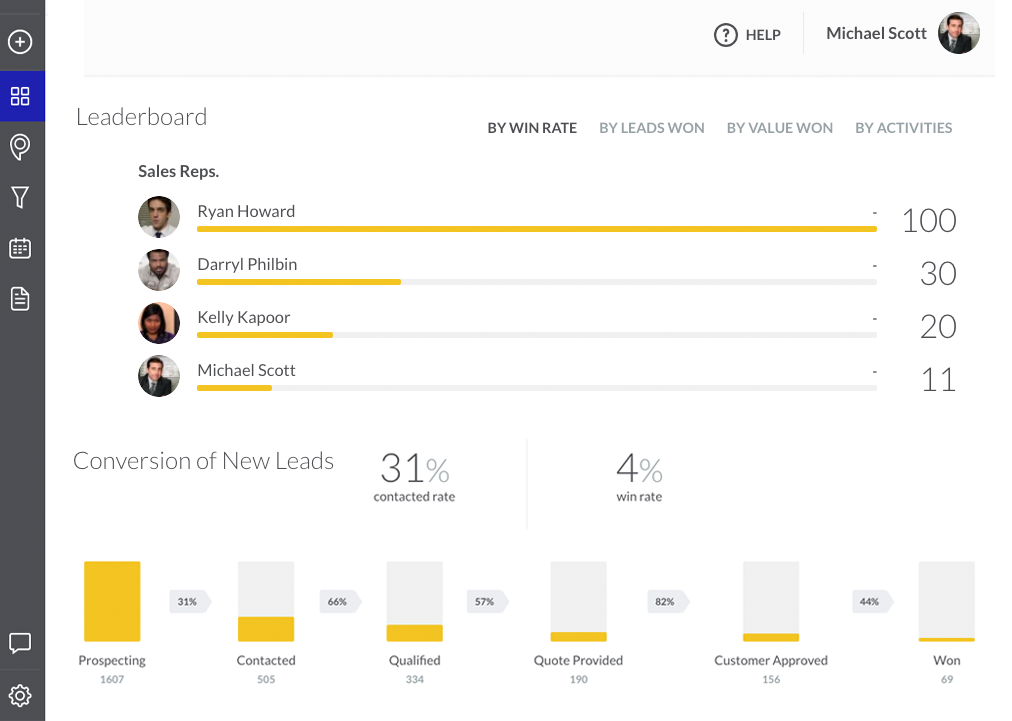
Here’s an example of SPOTIO’s sales leaderboard:
It breaks down everything. From the number of leads contacted to the territories that are closing the most sales, to the winnings of individual sales reps. It’s an excellent way to promote healthy competition within the team, but it also gives sales reps the chance to seek out the guidance of leaders on the board and ask—what’s your secret?
The end result: reps work accounts harder, and seek out cross-training opportunities.
How to Set Up a Sales Tracking Process?
Considering everything a sales tracking process can do to help your sales team, it’s a relatively easy process to set up. Once you figure out your goals, metrics, audience and process, all that’s left to do is map data to the key touchpoints.
Here’s five easy steps to set up a process of your own.
Step 1. Sets goals and objectives
First, it’s crucial to outline your sales goals and objectives. Otherwise, how does your team know what they are working towards?
Once you’ve decided what a realistic quota is for your team, discuss it with your sales managers—and your reps. After all, they’re the ones out in the field and can give you an honest answer about whether or not it’s achievable.
If your quotas are unrealistic, not only can it throw your goals off, but it can leave your sales reps feeling unmotivated and defeated.
Goals should be set at both the top line (leads, opportunities, sales, revenue etc) and the activity level (# calls made, # emails sent, # logged visits etc). This way, managers can ensure reps are doing everything they can in their direct control to create leads and close deals, while also showing how this activity impacts the top line of the company.
If activity-based goals are met, but top-line numbers are lagging, this could indicate a breakdown somewhere in the sales strategy or process.
Step 2. Identify your ideal customer profile
Next, figure out what your ideal customer profile looks like.
Are they trying to sell to a CEO of a company, or the head of IT? Is the prospect in their schedule a decision-maker, or a gatekeeper?
Knowing the attributes of your ideal customer will make the entire prospecting, qualification and closing process a lot easier for reps.
For example:
A rep would specifically know which of the 50+ data points – income, house size, credit capacity etc – to use inside SPOTIO’s Lead Machine to quickly find hundreds of highly qualified sales prospects in a given sales territory:
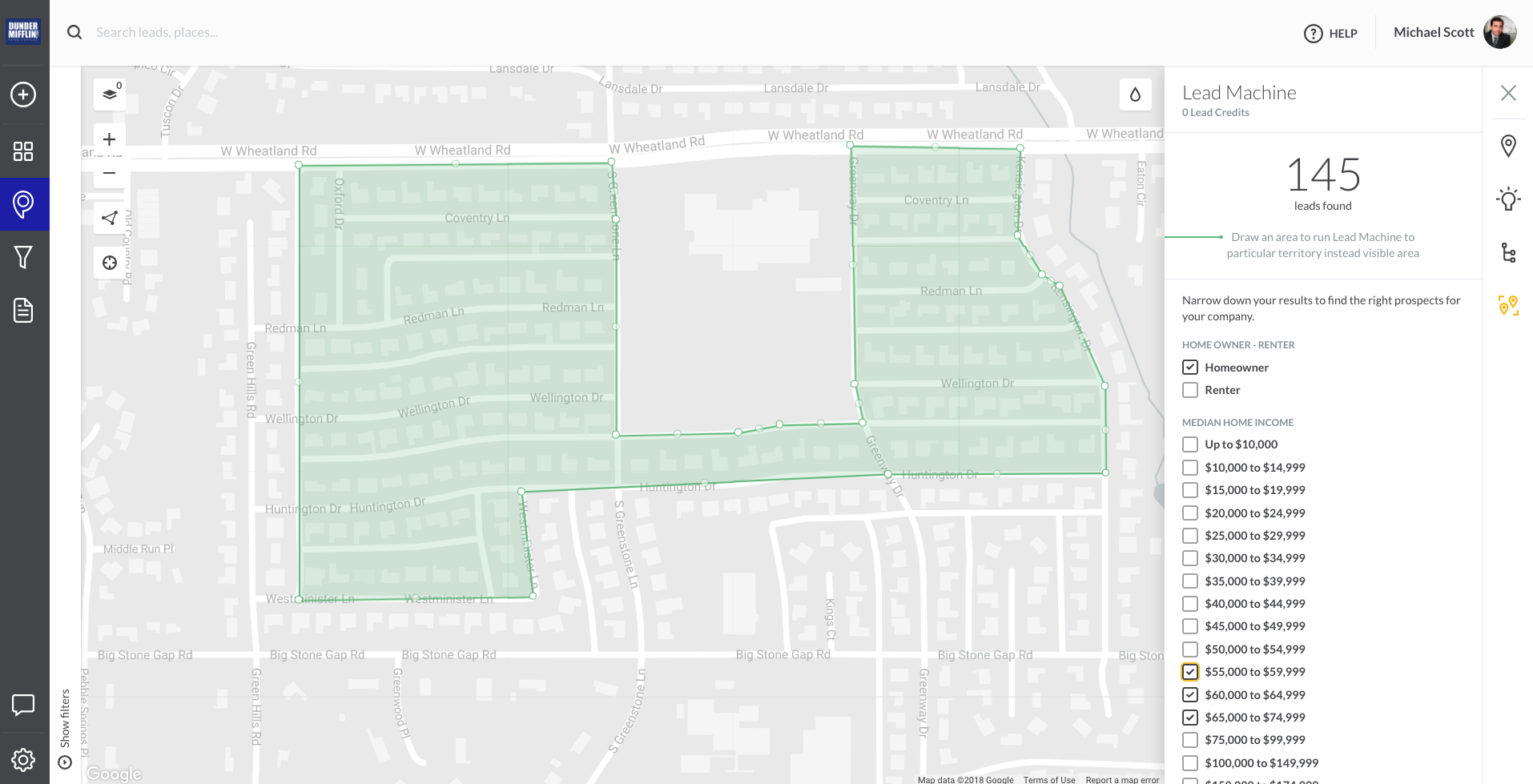
A clear outline of what your target customer looks like will save your reps time, and make closing deals easier.
Step 3. Identify contact sources
Once you know what your goals are and who your target customers look like, you need to formulate a plan for reaching and engaging this audience.
This involves identifying which channels your audience is already congregating on – LinkedIn, email, events etc – and producing messaging for the initial touchpoint and follow ups.
Step 4. Confirm each stage in the pipeline
When you are contacting prospects, you must know what stage they’re at in the pipeline.
Your approach to a qualified lead is going to be different from someone who has had a demo of your product. With sales tracking software, this information can be updated in real-time, so reps always know what stage every single lead is in their pipeline.

Even when your reps are out in the field, they’ll have real-time data on prospects, qualified leads, and closed deals within the same screen. And if they close a deal while they’re out selling, all they have to do is move them to customer approved!
Step 5. Map metrics to activities and goals
The final step is to assign specific KPIs and metrics to each stage of the sales process and pipeline.
For example:
If you determined that email, phone calls and door-to-door visits were the best channels for your audience, you’d map specific activity-based metrics to those channels to make sure prospects were being worked enough to generate a steady flow of leads.
- Phone: # calls made
- Email: # emails sent
- D2D: # logged visits
- General: # follow ups by channel
Once activity metrics have been mapped to key steps in the sales process, you’ll then move onto top-line performance tracking. Specifically, this is where we track lead volume, # opportunities, sales and revenue growth.
What Metrics Should Your Sales Team Track?
While every sales organization is different, there are some metrics every sales team should track.
Activity-based sales metrics to track
Activity-based sales metrics are metrics that your team has (at least) some control over. Through direct or indirect efforts of your sales team, you can impact the outcomes of metrics like:
- # of New prospects
- # of Calls Made
- # of Logged visits
- # of Emails sent
- # of Follow ups
- # of Upsells/cross-sells
- # of Demos
Results-based sales metrics to track
There are other metrics, however, that your sales team has less control over. These metrics are generally by-products of your sales process and how well your team executes its activities.
Examples of results-based metrics are areas like:
- # of qualified Leads
- # of opportunities
- Lead/Opportunity Rate
- # of closed deals
- Opportunity/close rate
- Average sales cycle
- Pipeline activity
- Pipeline value
- New revenue
Bonus resource: Need a more comprehensive list of common sales activities and metrics to track? Check out our complete guide to sales activity metrics here.
Invest in a Sales Tracking Solution
Building a brand new sales process can be overwhelming.
However, the work needed to implement a sales tracking process is outweighed by the benefits it will bring your team and your company’s bottom line. Tracking sales activities and results in real-time can be a game-changer for your team.
A dedicated sales activity tracker can simplify this entire process, so each member of the team—reps, managers and execs—can make informed decisions in real-time. For outside sales teams, investing in a sales tracking solution that integrates with your CRMs can help close more deals without shouldering more admin tasks.
__________
SPOTIO is the #1 field sales acceleration and performance management software that will increase revenue, maximize profitability, and boost sales productivity.


